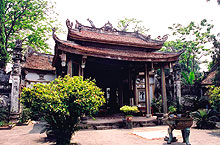Temple honours timeless love
Update: Mar 17, 2009
Located only 20 km south from Hanoi is the temple of Tien Dung Chu Dong Tu, a place to worship the immortal love between Princess Tien Dung and a poor fisherman, Chu Dong Tu.
 The temple was built from the basement of an ancient temple in 1894 by doctor Chu Manh Trinh who called in supporting labour and financial sources from eight hamlets in Me So Commune, Van Giang District. The temple was built from the basement of an ancient temple in 1894 by doctor Chu Manh Trinh who called in supporting labour and financial sources from eight hamlets in Me So Commune, Van Giang District.
There is a festival there every three years to commemorate the meeting of the couple, with a procession to the banks of the river and the temple and an incense ceremony.
The temple is in the Hung Yen Province’s Binh Minh Commune, Khoai Chau District. Go by motorcycle from Hanoi centre across the Chuong Duong Bridge and turn right along the dyke for about 20km. Or it can be accessed by river at the Hong (Red) River’s bank Tu Nhien with a walk on a 6m-wide tiled road to the temple gate with its two high pillars topped by kylins (a mythical lion) to protect the temple.
Along the road there are many big trees, including a plum that is more than 700 years. When it is in full fruit the tree is called the “love tree†by locals. Unmarried women an unhappy couples will get lucky when they worship under its branches, according to the old people here.
The temple is built on high ground with a view to Tu Nhien bank. It comprises three big rooms with the back chamber containing the tablets of the three personalities: Tien Dung, Chu Dong Tu and Tay Sa. There are many rare artefacts in the temple, such as a couple of pottery vases on which were written and sculptured 100 words meaning ‘longevity’.
In the legend that surrounds the temple, the third King of the Hung Dynasty had a beautiful daughter, Princess Tien Dung. Instead of settling down to a married life the princess preferred to visit places of interest in the country, in spring traveling by boat on rivers and even on the sea.
In the village of Chu Xa, Hung Yen, lived Chu Cu Van and his son Chu Dong Tu, poor fishermen whose home had been ruined by fire. They had lost their clothing except a single loincloth, which they took turns wearing. When the father fell seriously ill and felt death approaching, he called his son to the side of his mat and said to keep the loincloth after his death.
But Chu Dong Tu could not let his father be buried without a shroud. He attended the funeral in borrowed clothes and then found himself without a garment of any kind. The poor young fisherman was obliged to fish at night. During the day he would attempt to sell his catch to people in passing boats, remaining immersed in the river up to his waist.
One day, Princess Tien Dung, accompanied by a brilliant suite, happened to approach the place where Chu Dong Tu was standing in the water. When the young fisherman heard the sound of gongs and bells and saw the wonderful array of parasols and banners, he became frightened and took cover behind some bulrushes. Then he quickly dug a hole in the sand and covered himself completely.
Taking a liking to the picturesque surroundings, the princess decided to bathe there. A tent was set up on the shore, the princess entered, disrobed, and began to pour water over her head and shoulders. As the water trickled to the ground, it washed away some of the sand, exposing Chu Dong Tu in all his nakedness. Then they became a couple .
 Temple guard says the festival was held the 10th-13th days of the 2nd lunar month every three years. Temple guard says the festival was held the 10th-13th days of the 2nd lunar month every three years.
Opening the festival is the water procession which is preceded by a golden dragon, a good number of flags and parasols and a palanquin carrying a decorated stick and conical hat – the two sacred objects bestowed on Chu Dong Tu by the Buddha.
When the procession reaches the bank of the river, several decorated boats row to get water which is put in a jar, thus symbolising the act of providing a bath for Princess Tien Dung.
Thereafter, the procession makes for the temple for the incense-presenting ceremony, performed by a respected old man and old woman from the village.
Outside the temple, various games are organised such as wrestling, cock-fights, human chess and traditional and religious dances.
A touring ceremony is held on the second day. A procession of the three palanquins goes to various places around the village, including the Da Trach Lagoon, and stops at places where the couple Tien Dung and Chu Dong Tu are supposed to have stayed.
The ceremony provides an opportunity for visitors to see a performance of a meeting between the poor man, Chu Dong Tu, and Princess Tien Dung.
VNS
|
 |
|